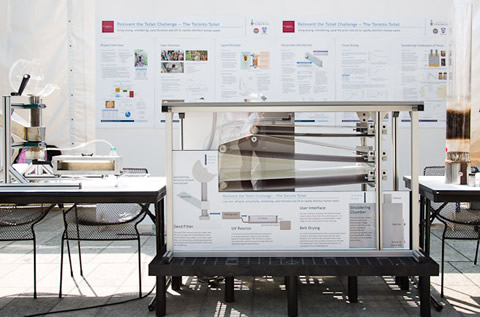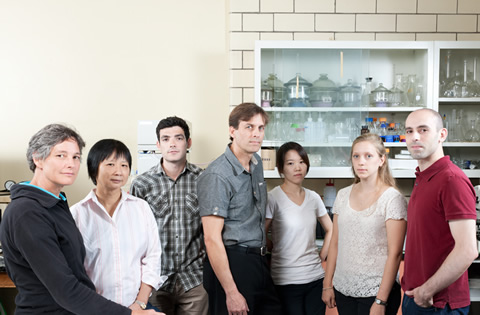The average North American home could barely function as a residence if it lost its connections to the outside world. Wires, cables and electromagnetic radiation pierce the walls to convey electricity, television, telephone, radio and the Internet. Out-of-sight pipes bring in gas and running water. Even that most humble household fixture, the toilet, is part of a network of water mains, grinder pumps and lift stations that stretches from a reservoir at one end to a sewage treatment plant at the other.
To most of us, a home is less like a castle and more like an organ pulsing in a vast circulatory system of utilities and information. This connectedness to “the grid” is so integral to the comforts of the developed world that it would seem impossible for low-income nations to ever attain a western standard of living without first making huge investments in costly infrastructure.
However, a new movement is challenging this assumption. At U of T and elsewhere, an informal alliance of engineers, designers, marketers and political scientists have become champions of a concept known as “frugal innovation.” This cross-disciplinary community of researchers seeks to develop simple, affordable technologies that use environmentally sustainable power sources and materials. Principles such as reducing, reusing and recycling that are often treated as remedial add-ons to North American lifestyles are built into frugal innovation from the beginning. The aim is to deliver western-style products and services in developing nations without western-style expense and resource usage.
As unassuming – or unappealing – as it might seem, the toilet has become a major focus of this new form of innovation. In North America, toilets account for nearly 40 per cent of a home’s water use, and even low-flow models use more than six litres per flush. This excessive use of water – let alone the construction of a massive sewage system to service such home fixtures – is unimaginable in many parts of the world.
So while many philanthropic efforts in low-income countries aim to provide sanitary toilets to prevent disease and improve the health of billions of people, using developed-world technology to do so would be economically and environmentally unsound. That’s why the Bill & Melinda Gates Foundation, in July 2011, issued a challenge to engineers to “reinvent the toilet.” Through its Centre for Global Engineering, U of T is fielding one of the eight teams from around the world who were invited to take up the Gates’ call.
Yu-Ling Cheng, the centre’s director, prefers the term “appropriate” to “frugal” when talking about innovation. She is concerned about the reinvented toilet’s affordability, but also believes that a successful design must draw on locally available materials and expertise for operation, maintenance and repairs. In addition, she says the design process must include consultations with the intended users to ensure the solution is one they want and will actually adopt. This process demands collaboration from start to finish, fresh thinking and a lot of work. If it’s successful, though, the impact could be extraordinary.
“I was attracted to this project because it’s a chance to help improve the lives of billions of people in need of better sanitation,” says Zachary Fishman, a research associate at the Centre for Global Engineering who is working on the science, engineering and design of U of T’s entry in the Gates challenge. He acknowledges that redesigning the toilet is not a particularly glamorous task, but he sees beyond the fixture itself to the impact it could have on the world.
A standard toilet, for instance, uses nearly 19 litres of water per flush. To put that in perspective, a single flush requires more water than a person living in poverty in a developing nation such as Rwanda or Cambodia typically uses in an entire day – for bathing, drinking, cooking and everything else. The average Canadian uses close to 350 litres in a day.
Toronto’s sewage system, with nearly 6,000 kilometres of water mains, is inarguably a triumph of engineering. But it is simply impossible to reproduce it for the 2.6 billion South Asians, sub-Saharan Africans and others who currently lack access to basic sanitation. Yet by making reliable, sanitary toilets available throughout the world, billions of lives could be vastly improved – and sometimes saved. About 1.5 million children die each year from diarrheal diseases that could be avoided through better sanitation and hygiene. Millions more become too sick to attend school.
The criteria for the Gates Foundation challenge focused on both affordability and appropriateness. Teams had to design a safe, hygienic toilet that would work for five cents per person per day and operate off the grid and without connection to a sewer. The U of T group wanted its design to be just as suitable for densely populated regions as for rural areas. And they knew their toilet had to be able to filter, separate, dry and disinfect human waste in a wide variety of climates, cultures and circumstances. All eight teams that were invited to participate – along with some 30 others – presented prototypes at the Gates Foundation’s campus in Seattle in August. U of T’s entry placed third, earning the team a US$40,000 prize. The U of T team hopes to receive additional funding for a second phase to refine and test their invention, but in mid-August the details for how this will proceed had yet to be confirmed.
In devising their winning approach, members of U of T’s team knew they would not be able to rely on access to water or specialized component parts. And they considered all existing off-the-grid toilet concepts inappropriate for the challenge. Composting is too slow to deal with high usage. Existing incineration systems demand too much power. And high-tech tools for dealing with organic waste, such as membrane filters and chemical composting accelerants, are too expensive and too complicated.
The team looked instead to sand. With their approach, when someone uses the toilet, liquids and solids are separated and dealt with individually. The solids are partially dried and then sanitized through a steady, low-energy smouldering process rather than energy-intensive incineration. Once the smouldering is started, it is self-sustaining as long as the toilet is in regular use.
The liquid side of the operation is more complicated. Because gastrointestinal bugs are so common, liquid waste often contains bits of fecal matter that must be further separated. The engineers found that sand makes a serviceable filter. Once urine and diarrhea pass through the sand, the liquid can be neutralized via solar-powered ultraviolet lights.
Of course, the sand itself becomes clogged and contaminated, and must be cleaned. This led to an elegant solution: sand also happens to provide ideal airflow for the smouldering process. Sand dirtied through filtering is cleansed through smouldering, meaning the same sand can be used repeatedly, moving back and forth from one function to the other. Not only is sand inexpensive, but it’s also widely available around the world, allowing for easy local maintenance. Once the solid waste has been smouldered, the ash can be discarded safely.

Not all parts of the team’s toilet can be found in nature. The separation system requires a moving belt that separates solids from liquid, and spreads the wet solids so they dry more quickly. The team has analyzed every component, seeking inexpensive, common technologies that are familiar to people in low-income countries. As Cheng emphasizes, the toilet must rely not only on locally available materials, but also on local knowledge for installation and repair. “At the moment, we’re using hardware-store sprockets, but we’re planning to adapt it to use bicycle sprockets,” says Fishman. “We’re currently using commercially available belt material. But we’re planning for that to be lower-cost plastic or something that could be produced locally.”
Cheng is aware that even the best design is useless if people don’t adopt it; reinventing the toilet isn’t merely a matter of, “If we build it, they will go.” Early in the project, the team conducted field research in Bangladesh. Even simple information such as the preference for squat toilets over western sit-down models, or the need for women to have a private place to change their clothes before and after using the facilities, prompted the team to refine their prototype.
The consultations yielded a spin-off benefit as well: a second, simpler, design project. “I came across a group of women talking about parents getting old or sick and being unable to use squat toilets – they would sometimes relieve themselves anywhere and these women would have to clean it up,” says Cheng. So she assigned students in one of her courses to develop ‘squatting assistance technology.’
In a matter of weeks, the students came up with a freestanding frame that’s light enough to be positioned over a squat loo when needed, and easily moved aside when not. It is sturdy enough to allow users to support themselves on it with their arms. “It’s a really neat design,” says Cheng. The product is aimed at elderly, middle-class Bangladeshis, but also pregnant women and people with illnesses and disabilities.
Such a project hints at the much wider range of issues around the world that might be addressed through frugal innovation.
Dilip Soman, a professor with the Rotman School of Management and the director of the India Innovation Institute, is one of Cheng’s collaborators in a broader effort to study low-cost innovation and the conditions that enable it to succeed. India has become a centre of innovation for everything from biotech to manufacturing, and Soman’s institute supports research on those success stories, situating them in a global context. He concurs that making a product inexpensive is often necessary but rarely sufficient to gain purchase in markets around the world. “One of the things we study is design deployment – getting people to use the thing,” he says. “Lots of great ideas fall by the wayside if you don’t think about how to get people to use them.”
Generally, frugal innovation focuses on re-engineering existing products rather than developing new ones. U of T–related examples range from tablet computers that cost less than $100, to transforming how hospitals provide medical oxygen to patients, to low-cost artificial limbs. Soman echoes many of his colleagues when he talks about the potential for industrialized countries to learn from low-cost products, services and business practices devised in developing nations. And India, in particular, he says, offers models that might find traction here in Canada. “As a behavioural psychologist, I’m aware that there’s a different mindset in India, something called jugaad,” he says. “Jugaad is one of those untranslatable Hindi words, but it essentially refers to using the things you have at hand to come up with solutions.”
He cites the example of the Nano, the least expensive factory-produced car in the world. Tata, the Indian manufacturer that created it, stripped away standard features such as power steering, airbags and one of the windshield wipers. “You start to look at things you don’t really need,” says Soman. “Traffic moves so slowly, the airbags would never deploy, and the car is so small you wouldn’t want them to.” The Nano’s merit is not just its low price tag (about $3,000), but its contextual suitability. “It’s all about thinking about the project being embedded in a larger environment. It is a psychological process more than a process of engineering. With the right mindset, you’re optimizing a different problem. You’re not trying to find a perfect solution; you’re trying to find something that works.”
Soman sees parallels between India and Canada that could facilitate frugal innovations moving from there to here. “One of the big health-care challenges in India is that population is distributed sparsely in some places and densely in others,” he says. Like Canadians, Indians contend with limited medical resources in rural areas, and the question of when to transport patients to urban centres for tests and treatments. India has become a leader in using mobile technology to supplement health care.
“Patients might see a doctor just once a year, so people have developed mobile-phone-based reminder systems, and use these devices to store medical records,” says Soman. “There are smartphone apps that ask patients a bunch of questions and then advise them whether to take a trip to the doctor. Those are all things we could use here. That would be fantastic.”
Even an off-the-grid toilet may find a place in North American society. Campsites and isolated northern communities would likely be the first beneficiaries, but such toilets may one day also find their way into even the most deeply grid-dependent household. “There’s no reason for the developed world not to adopt the technologies as well,” Cheng says. “They don’t require expensive infrastructure. But our ‘infrastructure inertia’ and ‘mindset inertia’ sometimes allow countries such as India to leapfrog ahead of us.”
Of course, local context will always require adjustment – a frugal solution that works in one region of India might not work elsewhere in the country, let alone in Tanzania, rural China or Canada. That is why a multidisciplinary, flexible approach to such challenges is the most promising avenue to finding solutions that can be adapted to many cultures and climates, and can change the lives of a diversity of people.
All those pipes and wires – the mesh that holds together our cities and our societies – are deeply ingrained in our sense of how life is supposed to work. We’re comfortable being on the grid, and we’re used to the complexity and expense of standard engineering solutions. Western society might only really embrace frugal innovation should the cost – economic or environmental – become so great that there is little other choice.
Patchen Barss is a Toronto-based journalist and author specializing in science, technology, research and culture.
***
UPDATE: Nov. 28, 2012: Yu-Ling Cheng and her U of T engineering team have received a grant worth $2.2 million for 15 months from the Bill and Melinda Gates Foundation to continue work on their design for a waterless, hygienic toilet that is safe and affordable for people in the developing world. Read more here.
***
Watch a video about U of T’s entry in the Gates Challenge:
U of T Reinvents The Toilet from U of T Engineering on Vimeo.
Recent Posts
People Worry That AI Will Replace Workers. But It Could Make Some More Productive
These scholars say artificial intelligence could help reduce income inequality
A Sentinel for Global Health
AI is promising a better – and faster – way to monitor the world for emerging medical threats
The Age of Deception
AI is generating a disinformation arms race. The window to stop it may be closing






3 Responses to “ Frugal Thinking ”
Enjoyed the article on toilets and appropriate technology very much. Miss receiving The Bulletin - does it still exist?
Yes, in electronic form only. You can sign up to receive The Bulletin by sending your email address to bulletin [at] utoronto [dot] ca
My name is Simona Rivera, I am an Italian medical doctor. I got very interested in an article I recently read about your “Frugal Thinking” invention of sanitary toilets that can be used in countries where no proper sewage system is available.
From this coming November 23, I will have the opportunity of working as volunteer in Rio de Janeiro’s “Rocinha,” the biggest Favela of South America (about 100,000 inhabitants). Rocinha has essentially no waterworks, and a number of open-air raw sewage drains that freely overflow on the streets during the rainy season. This is the reason for a proliferating number of infections that, due to the lack of basic health care, often lead to death, especially for children. When I read your article, I thought that Rocinha could be a very right place for testing your promising invention. I decided to contact you since I would like to know if it is possible that your campaign could cover also Brasil, and not only China, India and Tanzania. Also, I am interested in keeping in touch with you, and in receiving more information about the functioning and possibilities of your new sanitary toilet.
I thank you in advance for you kind attention and I am looking forward to hearing from you.